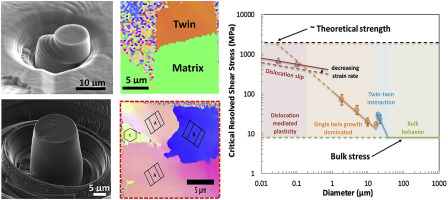当前位置:
X-MOL 学术
›
Acta Mater.
›
论文详情
Our official English website, www.x-mol.net, welcomes your
feedback! (Note: you will need to create a separate account there.)
Anomalous hardening in magnesium driven by a size-dependent transition in deformation modes
Acta Materialia ( IF 8.3 ) Pub Date : 2018-02-01 , DOI: 10.1016/j.actamat.2017.10.033 Gi-Dong Sim , Gyuseok Kim , Steven Lavenstein , Mohamed H. Hamza , Haidong Fan , Jaafar A. El-Awady
Acta Materialia ( IF 8.3 ) Pub Date : 2018-02-01 , DOI: 10.1016/j.actamat.2017.10.033 Gi-Dong Sim , Gyuseok Kim , Steven Lavenstein , Mohamed H. Hamza , Haidong Fan , Jaafar A. El-Awady

|
Abstract Here, we report a comprehensive study that combines in situ scanning electron microscopy experiments and atomistic simulations to quantify the effect of crystal size on the transformation in deformation modes in a-axis oriented Mg single crystals at room temperature. The experimental results indicate that the deformation is dominated by the nucleation and propagation of tensile twins. The stress required for twin propagation was found to increase with decreasing sample size, showing a typical “smaller is stronger” behavior. Furthermore, an anomalous increase in strain hardening is first reported for microcrystals having diameters larger than ∼18 μm, which is induced by twin-twin and dislocation-twin interactions. The hardening rate gradually decreases toward the bulk response as the microcrystal size increases. Below 18 μm, deformation is dominated by the nucleation and propagation of a single tensile twin followed by basal slip activity in the twinned crystal, leading to no apparent hardening. In addition, molecular dynamics simulations indicate a transition from twinning mediated plasticity to dislocation mediated plasticity for crystal sizes below a few hundred nanometers in size. A deformation mechanism map for twin oriented Mg single crystals, ranging from the nano-scale to bulk scale is proposed based on the current simulations and experiments. The current predicted size-affected deformation mechanism of twin oriented Mg single crystals can lead to better understanding of the competition between dislocations plasticity and twinning plasticity.
中文翻译:

由变形模式中的尺寸相关转变驱动的镁的异常硬化
摘要 在这里,我们报告了一项综合研究,该研究结合了原位扫描电子显微镜实验和原子模拟,以量化晶体尺寸对室温下 a 轴取向 Mg 单晶变形模式转变的影响。实验结果表明,变形以拉伸孪晶的形核和扩展为主。发现双胞胎传播所需的应力随着样品尺寸的减小而增加,显示出典型的“越小越强”的行为。此外,首次报道了直径大于 18 μm 的微晶的应变硬化异常增加,这是由孪晶和位错孪晶相互作用引起的。随着微晶尺寸的增加,硬化速率向体响应逐渐降低。18微米以下,变形由单个拉伸孪晶的成核和传播主导,然后是孪晶晶体中的基底滑移活动,导致没有明显的硬化。此外,分子动力学模拟表明,对于尺寸低于几百纳米的晶体尺寸,从孪晶介导的塑性向位错介导的塑性转变。基于当前的模拟和实验,提出了从纳米尺度到块体尺度的孪晶取向镁单晶变形机制图。目前预测的孪晶取向镁单晶的尺寸影响变形机制可以更好地理解位错塑性和孪晶塑性之间的竞争。
更新日期:2018-02-01
中文翻译:

由变形模式中的尺寸相关转变驱动的镁的异常硬化
摘要 在这里,我们报告了一项综合研究,该研究结合了原位扫描电子显微镜实验和原子模拟,以量化晶体尺寸对室温下 a 轴取向 Mg 单晶变形模式转变的影响。实验结果表明,变形以拉伸孪晶的形核和扩展为主。发现双胞胎传播所需的应力随着样品尺寸的减小而增加,显示出典型的“越小越强”的行为。此外,首次报道了直径大于 18 μm 的微晶的应变硬化异常增加,这是由孪晶和位错孪晶相互作用引起的。随着微晶尺寸的增加,硬化速率向体响应逐渐降低。18微米以下,变形由单个拉伸孪晶的成核和传播主导,然后是孪晶晶体中的基底滑移活动,导致没有明显的硬化。此外,分子动力学模拟表明,对于尺寸低于几百纳米的晶体尺寸,从孪晶介导的塑性向位错介导的塑性转变。基于当前的模拟和实验,提出了从纳米尺度到块体尺度的孪晶取向镁单晶变形机制图。目前预测的孪晶取向镁单晶的尺寸影响变形机制可以更好地理解位错塑性和孪晶塑性之间的竞争。











































 京公网安备 11010802027423号
京公网安备 11010802027423号